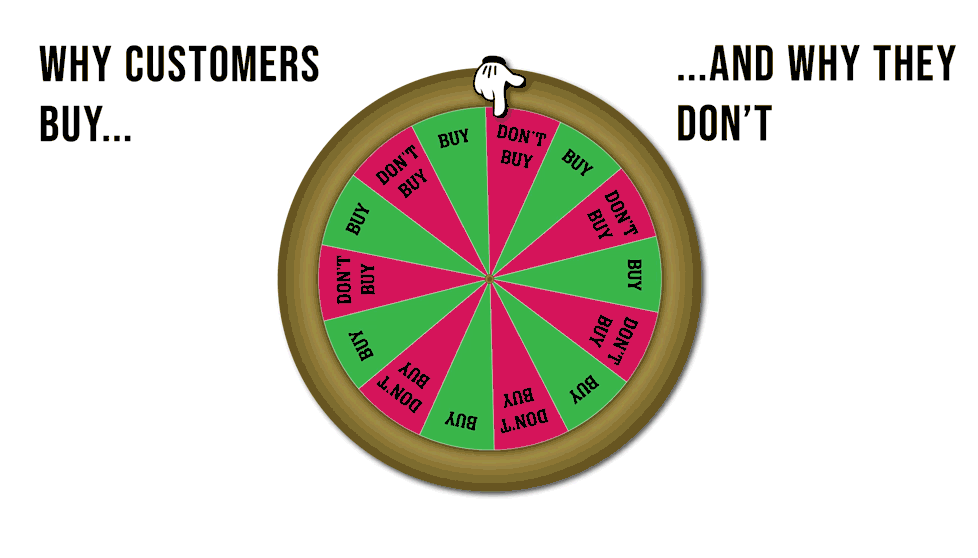There is no shortage of ideas and theories about the reasons why customers buy one product over another. From the slightly sciencey ‘marginal utility theory’ to the slightly bullshitty ‘millennials buy experiences’. Somewhere in the middle live the well-worn models we are all familiar with; ‘people buy solutions not products’ and that sort of thing.
The one thing all of these theories have in common is they look for the positive reasons why people buy. They tend not to look at the reasons why they don’t – or rather they assume that the negative reasons are merely the inverse of the positive. If ‘good value’ is a reason to buy, then ‘poor value’ is a reason not to. It’s not a simple as that. As we shall see.
Most sales are to individuals and businesses that have previously purchased a similar product. Whether you are selling photocopy paper or jet engines, MRI scanners or toothpaste, your prospective customer invariably has a current supplier. Sales and Marketing’s job, when looking to add new customers, is to convince the buyer to change their mind. And that often takes a lot more than marginally improving on that which they currently enjoy.
You can think of this as a two-step process. Firstly, your offer must be a credible, improved alternative to what is currently available, secondly, you need to overcome the customers’ inherent resistance to change. It would be reasonable to assume a strong, inverse relationship between these two steps. That the better the offer, the lower the resistance. But that isn’t always, or indeed often, the case.

The venerable aphorism that if you build a better mousetrap, customers will beat a path to your door, ignores the fact that many customers will find the effort required to beat a path to your door sufficient reason not to buy your better mousetrap. Especially if it isn’t that much better than their current mousetrap.
When constructing a value proposition the best approach is to first focus on the reasons why people should buy your product, and then, separately and distinctly, focus on the reasons why they might not. Take a look down both ends of the telescope, so to speak, before you develop your marketing strategy and build your offer.
Let’s start with the positives. The seven broad reasons why customers buy. Many, if not all, will be familiar to you. The following, singularly or in some combination, form the backbone of just about every value proposition you will ever see.
1) Financial
Well, no surprises here. The prospect of making or saving money has been, and remains, one of the most popular reasons to buy anything. From crude discounting to a more sophisticated return on investment calculations, many offers make the compelling and simple claim to save you money or make you money. ‘No-frills’ budget airlines are predominantly a financial offer.
2) Peace of mind
Modern life is full of uncertainty, insecurity, and anxiety (but enough about me). Many value propositions claim to reduce this stress and worry. The ‘one less thing to worry about’ offer can take the obvious form of insurance, warranties, and guarantees or the more subtle and implied reassurance of reputation and product quality. “Nobody ever got fired for hiring IBM” is a classic example. “FedEx …when it absolutely, positively has to be there overnight” is another.
3) Convenience
Another factor in modern life is time pressure. We all have more than enough to do, not enough time to do it, and plenty of things we would rather be doing. A convenience offer is a promise to give some time back and make things more effortless. Come up with a product or service that makes it more convenient or simpler to do something that the customer is already doing, and you have the basis for a strong offer. Uber is a good example. So is Amazon’s Kindle.
4) Status
What other people think of you matters more than most of us care to admit. Luxury brands understand this. Providing people with conspicuous ways to signal their wealth and status can be a lucrative business. No one straps a $20,000 Rolex on their wrist to tell the time. But status is not always about being ostentatious or flashy. Making a customer look good by helping them deliver on their targets, enhancing their reputation with colleagues or making them look smart to their boss are all ways to use status in your value proposition. Savvy businesses make their customers look good to others.
5) Values
Values are a less obvious, softer type of behaviour driver, but can be just as important. Values are more internal than external. It’s not what others think of us that counts, it’s what we think of us. We choose products and suppliers, all other things being equal, that resonate with our intrinsic values and reflect what is truly important to us. This topic is too big to cover, in any detail, in this article but as an example look at Apple’s early ads for Mac v PC – they relied heavily on values.
6) Comfort
For most human history we have been in survival mode. Our focus was on making sure we had enough food, making sure we didn’t become food and surviving long enough to reproduce. Fortunately, many of us no longer have to worry about such things and our focus has shifted more to comfort. Incidentally, ‘comfort’ wasn’t used in its modern sense until the eighteenth century. Before that not only did we not enjoy much comfort, we didn’t even have a word for it. But Comfort, as we think of it today, is not just limited to softer pillows, reclining chairs and elasticated waistbands. Any change to the ergonomics of a product that makes them easier and more comfortable to use can be the basis of an offer.
7) Enjoyment
We humans like to enjoy ourselves. We want to have fun. The desire to be entertained and amused is a universal part of the human condition. Recreation and leisure are important aspects of our existence. The obvious businesses that care about this would be those in the entertainment and hospitality industry or the tourism business, but almost any enterprise can benefit by simply being ‘fun to work with’. It might not be part of your declared offer, but it should be part of the resulting experience (not if you’re a funeral director, obviously, but you get the general point)
From Why? To Why Not?
So there you have it. The magnificent seven reasons why customers buy. Think of any value proposition and you will be able to tie it back to one of the above, or more commonly, a combination of the above. When you are considering the components of your offer this is a pretty good checklist to work through.
But sometimes, even when faced with an offer that is objectively better than they currently enjoy, some customers seem less inclined to move than a fat bloke living next to a pie shop. Of course, this reticence is a double-edged sword; if you are looking to lure a potential customer from their current supplier, it can be a problem but if you are trying to keep your existing customers out of the arms of a rival, it can be a big help. Whatever your position in the scenario, here are the seven reasons people don’t buy.
1) Inertia
This is the business equivalent of Newton’s first law, which states that a body will remain in its current state unless acted upon by an outside force. In physics, the degree of force needed to effect a significant change depends on the mass and momentum of the object in question. But in terms of changing a customer’s mind, it gets a little more complicated.
The force needed to change a customer’s mind depends on multiple factors; How apathetic are they? What else is occupying their mind? What degree of improvement are you offering? How important that improvement is in the overall scheme of things? How easy the change is to implement? What are the perceived risks of change? and how much do they believe you? (yes, it’s true, some businesses have been known to exaggerate the potential benefits of their products).
2) Consistency
When a person makes a decision, they tend to stick with it. Even when faced with evidence that challenges their initial judgment, many people will stick to their original choice. While this makes no logical sense, the phenomenon of confirmation bias is well supported in psychology literature. People like to stick with the decisions they have made.
If your target customer has been instrumental in selecting their current supplier or has been in a position to recommend them or defend them, they will feel the need to be consistent. In many ways, consistency is similar to inertia. The main difference is that while inertia tends to be a passive state, consistency is more active, and therefore harder to subsequently change.
3) Reciprocity
When a customer feels they owe their current supplier a degree of fidelity it creates a high barrier to entry for any potential new supplier to get over. The potential drivers of this fidelity are many and varied. It could be a sense of indebtedness, where the customer has benefitted from a supplier’s historical support with a critical issue. It could be a broad appreciation of a supplier’s efforts and general levels of service. It may even result from the lavish attention and entertainment the customer has received. Whatever the cause, if your prospective customers feel ‘honour-bound’ to support their existing supplier it will take a lot more than a marginally better offer to shift them.
4) Herding
In nature, animals herd together for collective safety. That instinct also crops up in customer behaviour. Albeit in a subtle way. I recently had cause to meet with a few healthcare professionals in a short space of time, as a patient, as a hospital visitor, and as a dog owner, going to the vet. On each occasion, the doctor/nurse/veterinarian used the same brand of a stethoscope. This intrigued me so I looked at the market for these devices and found several competitors. Yet one brand stood out as a market leader. I asked a doctor friend of mine why this brand was so prevalent, and he said, “Because everybody uses them”. When faced with a choice people sometimes look for what their peers are doing and then do the same. There is safety in numbers (and an implied risk of being different)
5) Personal Relationship
In theory, business relationships should be strictly business, with no room for personal relationships. But thankfully, that is a custom more honoured in the breach than the observance. I mean who would want to live in a purely transactional world? But this goes beyond personal preference. Deep in our evolutionary history is an inclination for the familiar and distrust of strangers. Any personal relationship your prospective customer has with their existing supplier will act as a barrier to entry for you. This will be further exacerbated by the degree you are unknown to them.
6) Trust & Confidence
When your prospective customer believes that their current product or service will perform exactly as they expect, and they trust that in the event of a problem their supplier will move quickly to resolve the issue they will be somewhat reluctant to change. The incumbent supplier has the advantage of building trust and confidence and creating the ‘risk of change’ barrier that any subsequent suitor will have to get over. Experience trumps promise every time.
7) Affinity
Affinity is a deep and personal connection to a brand or product. When a customer’s self-image is inextricably linked to a brand, you have a close to zero chance of shifting them. Try persuading a Harley Davidson owner to switch to a Honda. Of Course, brands like Harley Davidson are extreme and exceptional but affinity exists on a spectrum.
If a supplier or brand has any degree of personal connection to a customer, say by a perceived sharing of values or by helping the customer’s self-expression, there will exist a significant reason not to change suppliers.
Summary
The primary concern of marketing is the acquisition of new customers. This makes perfect sense, as the only way to grow a business is by expanding its customer base. Some may argue that you could grow by getting existing customers to buy more or getting them to pay higher prices. But they would be wrong. The only way you will grow your business, in the long term, is by recruiting more customers at your chosen price point while holding on to the ones you currently have.
Given this imperative, businesses put a lot of effort into building products or services that give customers a strong reason to buy. This is not only common sense, but it is also of critical importance. However, it is not the only thing to consider. When you factor in the reasons why customers don’t buy, you will develop a more compelling value proposition. Don’t focus 100% on your product, spend time considering how you might mitigate some of the common reasons people don’t buy.
If you are pursuing a new customer then the stories you tell, the way you craft and develop your brand, the testimonials you provide and the messages you communicate should address not only the strength of your product but the virtues of you as a supplier.
If you are trying to keep existing customers on board, in the face of a concerted attack by one of your competitors, build your defenses based on the seven reasons why customers don’t buy.
Whether you are playing defense or offence, focus on the why along with the why not.

 Sean Welham
Sean Welham














